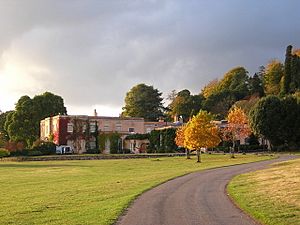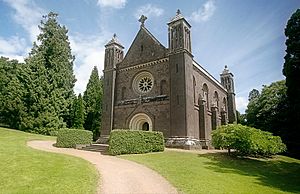Killerton facts for kids
Quick facts for kids Killerton |
|
|---|---|

Killerton House
|
|
| Type | Country House |
| Location | Broadclyst |
| OS grid reference | SS 97349 00089 |
| Area | Devon |
| Built | 1778 |
| Architect | John Johnson |
| Owner | National Trust |
|
Listed Building – Grade II*
|
|
| Official name: Killerton House and Ha Ha approximately 20 metres in front of entrance | |
| Designated | 11 November 1952 |
| Reference no. | 1098331 |
|
Listed Building – Grade II*
|
|
| Official name: The Bear's Hut 220 metres North West of Killerton House | |
| Designated | 20 May 1985 |
| Reference no. | 1170706 |
| Official name: Killerton House | |
| Designated | 12 Aug 1987 |
| Reference no. | 1000694 |
| Lua error in Module:Location_map at line 420: attempt to index field 'wikibase' (a nil value). | |
Killerton is a beautiful old house from the 1700s. It is located in Broadclyst, near Exeter, in Devon, England. This amazing house, along with its large hillside garden and surrounding land, has been looked after by the National Trust since 1944. Today, it is open for everyone to visit and explore.
The National Trust has made Killerton House feel like a cozy, comfortable home. Inside, you can see a special collection of clothes from the 1700s to the 1900s. These costumes, originally from the Paulise de Bush collection, are displayed in rooms that look just like they would have back then.
The entire Killerton estate is huge, covering about 2,590 hectares (that's like 6,400 football fields!). This land includes a steep, wooded hill. At the very top of this hill, you can find the remains of an Iron Age hill fort called Dolbury. There's also evidence that the Romans used this spot, with a triple-ditched Roman fort that you can still see in aerial photos, even though the land has been farmed a lot.
Both Killerton House itself and a small summerhouse called the Bear's Hut in the grounds are special historic buildings. They are listed as Grade II*, meaning they are very important. The beautiful gardens are also listed as Grade II* in the National Register of Historic Parks and Gardens.
Contents
Discovering Killerton's Past
The land around Killerton has a long history. In the early 1600s, a powerful family called the Aclands started to buy up land here. Sir John Acland, who was a Member of Parliament, bought the nearby area of Columbjohn. Soon after, his nephew, Sir Arthur Acland, bought the Killerton estate in 1612.
The Killerton House you see today was built much later, in 1778. It was built by Sir Thomas Acland, 7th baronet, who was a member of the same Acland family. The small chapel on the estate was built even earlier, in 1738. It was designed by an architect named Charles Robert Cockerell.
The Beautiful Gardens of Killerton
The amazing gardens at Killerton were created in the 1770s. They were designed by John Veitch, who was one of the best garden designers of his time. The gardens are famous for their colorful rhododendrons and magnolias. You can also see lovely flower beds called herbaceous borders and many rare trees.
Hidden within the gardens are an ice house, which was like an old-fashioned refrigerator, and a charming early 1800s summer house. The large parkland and woods around the house are perfect for walks. In 2016, a short play was even performed in the gardens, telling the story of a meeting between John Veitch and another garden designer, William Sawrey Gilpin.
Killerton's Gift to the Nation
Killerton was given to the National Trust in 1944 by Sir Richard Acland, 15th Baronet. He was a British politician who believed that special places like Killerton should be shared with everyone. In 2015, the National Trust put on a play called The Gift at Killerton. This play told the story of why Sir Richard decided to give his family estate to the nation.
The Mystery of the Lost House
In 2016, something very exciting happened at Killerton! Archaeologists, who are like history detectives, started digging in the grounds. They discovered what they believe is the outline of a house that was planned to replace the current Killerton House. For 240 years, this had been known as the "lost house of Devon."
This lost house was designed by a famous architect named James Wyatt. It's located a short walk from the current house. Its existence was hidden for a long time by a group of trees that seemed to have been planted on purpose to keep it a secret.
To help visitors imagine what the lost house would have looked like, the National Trust has placed wooden markers. These show where the four corners of the planned building would have been. They've even put up a door and frame where they think the entrance to the billiard room would have been! The information boards at Killerton say that more archaeological digs are planned for the future to uncover more secrets.


